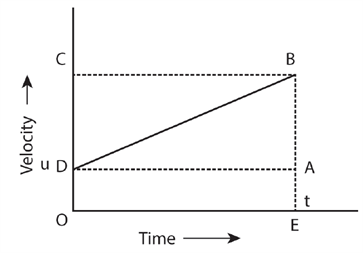
PUMPA - SMART LEARNING
எங்கள் ஆசிரியர்களுடன் 1-ஆன்-1 ஆலோசனை நேரத்தைப் பெறுங்கள். டாப்பர் ஆவதற்கு நாங்கள் பயிற்சி அளிப்போம்
Book Free Demo1. Derive equations of motion by graphical method.
Solution:
An object is in motion with initial\ velocity\ u attains a final\ velocity\ v in time\ t due to acceleration\ a, with displacement\ S.
Let us try to derive these equations by graphical method.
Equations of motion from velocity – time graph:

From the above graph, we can observe that the velocity changes with time for a uniformly accelerated object.
The object starts from the point D in the graph with velocity u. The velocity of an object keeps increasing, and after time (t), it reaches the point B on the graph.
Therefore,
The initial velocity of the object,
Then, the final velocity of an object,
Time,
From the graph, we can also find that AB\ =\ DC
i) First equation of motion:
We already knew that acceleration,
Substitute the values and simplifying,
First equation of motion,
Second equation of motion,
Third equation of motion,